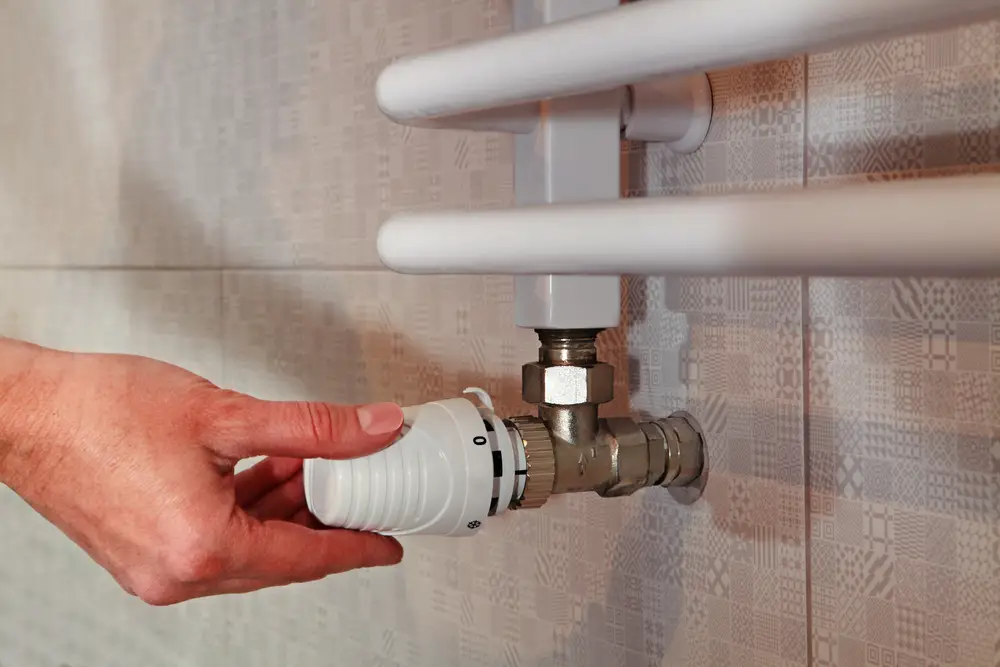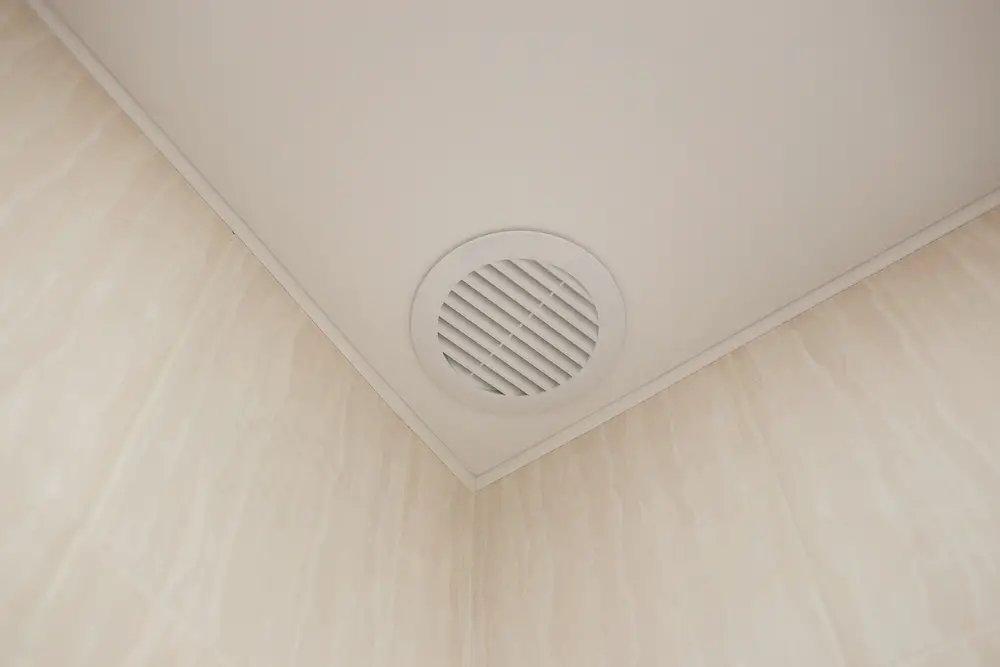You would have encountered a cooling sensation or a temperature drop once you step into your bathroom, particularly in winter. So, why is your bathroom so cold compared to the rest of the house? What can you also do to minimize the heat losses from your bathroom?
Bathrooms feel cold for several reasons, firstly you often have little or no clothes on in the bathroom when you go to get washed. The materials in a bathroom are hard surfaces, reflecting cold air without and allowing evaporative cooling. Often, windows will be opened in a bathroom to allow the removal of water vapor (and heat too).
The above-stated reasons are the major factors that influence the temperature of the Bathroom. We would now go into detail on how these factors occur and how you can improve the Bathroom temperature.

Reasons why your Bathroom is Cold
The following are the reasons why your bathroom is colder than other rooms in your house:
- The Bathroom’s wall finishing: Most bathroom walls are usually made up of hard materials such as tiles, porcelain, and marbles. These materials are impenetrable to water and they reflect cold air. Since they are also good conductors, the cool air below the tile surface from the ground is passed to the top of the tiles as well.
- Evaporative cooling: Once you have taken bath, the water on your skin begins to dry off. As this happens, you tend to feel colder as the air hits your skin. This is because the temperature of the body is higher than that of the cold air. Also for bathrooms with exhaustive fans, these fans help to move out air once you get out of the bathroom. These fans speed up the evaporation process and can make the room feel even colder.
- Lack of Clothes in your Bathroom: As soon as you enter the bathroom, you take off your clothes. This consequentially leads to the cold sensation you feel. In areas where the average temperature is even lower, you would even feel cooler since you have no clothes on.
- Lack of heat source in the Bathroom: In most cases, bathroom heating is often overlooked. Most houses do not have a heating system in the Bathroom hence the bathroom is colder. This is also because the central heating system deployed in the house may not be compatible with the bathroom space as well. Also, bathrooms usually have smaller windows and may not allow enough sunlight into the bathroom. This also contributes to why the bathroom is also colder than other rooms.

Ways to reduce heat loss in a Bathroom
The following are the ways to reduce heat loss from the bathroom:
- Insulation: This is the most efficient means of preventing heat loss in the bathroom. The walls and floor are sealed to prevent any form of air leakage from the bathroom space. Fiberglass and spray foam insulation are majorly used for bathroom insulation. Fiberglass is vulnerable to moisture and should be placed far from damp areas. Spray foam insulation is quite expensive but it gets the job done, even in damp areas.
- Additional heat source: Although, this is not the most efficient means of negating heat loss it works also. The additional heat source helps to make up for the loss originally. This is not advisable as it can be very expensive to operate. But it can be seen as a quick fix for certain situations.
- Controlled extractor fans: In bathrooms where there are extractor fans, you can time these fans to run for a particular time after a shower. If the fans are not regulated, it could make the bathroom even colder.
- Airtight doors and windows: To further prevent heat loss, you may need to install airtight doors and windows. These types of doors and windows have seals that help prevent heat from escaping to the surroundings. Bathroom windows are usually very small, but you can make yours bigger to allow more sunlight into the bathroom while ensuring the window is airtight. As a result, you would need to install larger curtains for privacy.

Bathroom Insulation
How are Bathrooms insulated?
Bathrooms require insulation to prevent heat loss and mold growth caused due to moisture retention. Bathrooms insulation is made up of three components, the walls, the floors, and the pipings.
The walls and floors are installed the same way. You would need to insulate inside the wall cavity and between studs. Cut off excess insulation materials while you ensure there are a few centimeters of tolerance on either side to ensure a tight fit. Ensure that all gaps, nooks, and crannies are covered very well. Also to prevent moisture penetration, you can also install a vapor diffusion barrier with the insulation material.
For the pipes, ensure they are dry and free from foreign materials before you start insulating. The insulating material(e.g fiberglass) is wrapped around the pipe. Also, ensure the entire length of the pipe is covered and each end secured with tape.

How to add insulation to your bathroom – is it a big job? Are there any quick fixes
For Bathrooms, you can either make use of fiberglass insulation or spray foam. While spray foam is much pricey, it gets the job done effectively. Fiberglass, on the other hand, is also a good alternative but should be kept away from the shower areas, where moisture contact is quite high.
Fiberglass is very easy to install. You can have it installed by yourself without any professional help. Sprayfoam is not as straightforward. You would need to hire the services of a professional to correctly install the spray foam insulation. This is to ensure that the right amount is spread at the right depth and evenly across the room.
In situations whereby the walls have already been constructed(tiled) before installing the insulation, the job at hand becomes more difficult. This is because it becomes much harder to access the wall cavity, where the insulation would lay. At this point, it would be best to hire a professional. The installation process is usually the same for all countries(except otherwise stated by their building code).
Heat loss through a bathroom external fan
The external fan in the bathroom works in the principle of evaporating cooling. It is used to remove moisture and vapor from the bathroom immediately after a shower. Most homeowners do leave their bathroom fans all the time and this can lead to unwanted heat loss.
Also, the design of an external fan makes the room lose heat passively. The external fan has an outlet where the vapor evaporates when it’s in operation. But when the fan is not in operation you cannot shut the vents. This vent is linked with the backdraft damper which allows air to escape. Also, a bad backdraft damper could spell doom for your bathroom temperature.
Also, ensure your bathroom fan is sized appropriately. This is to avoid rapid and uncontrolled heat loss from not only the bathroom but from the entire house.

Effects of Hard smooth surfaces eg tile
The use of hard materials for floor and wall finishings is one of the main reasons for the Bathroom’s temperature. Tiles, Marble, Porcelain, and other hard floor finishings are very good conductors of heat, so once you step on the floor, it extracts the heat from your feet hence you feel cold. Also, these same materials, reflect cold air. They are directly linked to the ground surface which is always cold, especially in cold weather conditions. These materials are not like carpets or rugs that keep preserving heat for longer periods, they conduct heat as soon as they get in contact with heat sources.
Underfloor heating in bathrooms
Underfloor heating is the safest and most efficient heating system for bathrooms. They are of two types; Water and Electric Underfloor heating. The water underfloor heating is not too suited to bathrooms since the bathroom space is quite small. Also, the availability of fixed fittings in the bathroom makes it difficult to install them in bathrooms.
Electric underfloor heating systems are more suited to bathrooms and smaller spaces. They are very flexible and can easily maneuver across the fittings in the bathroom. They are quite easy to install. Electric underfloor heating also prevents the formation of molds hence preserving the integrity of the floor and walls.
What steps can you take when getting a new bathroom?
The following are the steps to take when getting a new bathroom:
- Planning and creating a budget for the Bathroom.
- Purchase the materials for your bathroom.
- Plan insulation and consider an extractor fan or towel warmer / heated towel rail
- Strongly consider underfloor heating if you have the budget
- Set your underfloor heating, towel rail,
- or other heating sources to come on early in the morning, via a smart thermostat, so your bathroom is nice and warm for your morning shower.
Conclusion
Bathrooms are always colder than the rest of the house, unless we do something about it. The materials used in constructing one, and how its constructed all lead to this phenomenon. The most obvious reason why it is always cold is why we go there in the first place. The bathroom is the place where we are wet and have the least clothes on. Also, evaporative cooling takes place while in the bathroom, making it seem much colder than normal.
The heat loss in the bathroom can also be reduced drastically by insulating the walls, floors, and pipes. The homeowner may decide to install the insulation by themselves or hire a professional. Also, before planning to install insulation in your bathroom, ensure you understand the whole process very well to prevent accidents later on.
